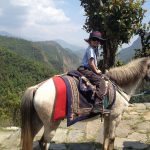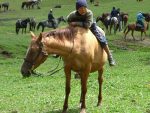Indian Country-Bred Horse
The Indian Country-bred, produced due to indeterminate cross breeding, is an equine type found in India. Although it is commonly referred to as a horse type, the animals are much smaller than the average horses. They may differ in physical characteristics varying from poorly conformed equines to good-quality sturdy horses. They are incredibly resilient and are suited to the cold climate and mountainous terrain.
Indian Country-Bred Horse Pictures
- Indian Country-Bred Horse Images
- Indian Country-bred Horse
Quick Information
| Temperament / Personality | Quiet, willing, obedient |
| Physical Characteristics | Large head, pronounced jaw, low withers, long neck, deep and narrow chest, sloping quarters, fairly straight and upright shoulders, short and strong legs, strong hooves, a low-set tail |
| Colors | Gray, dun, roan, and chestnut are common; other solid colors are rare |
| Height (size) | 12-13.2 hands (121.9-134 cm, 48-52.8 inches) |
| Common Uses | Draft and pack animal; also as a riding pony |
| Health | Predisposed to heat stroke as it has low tolerance for humidity and heat |
| Feeding/Diet | Good quality, dust-free forage, low amount grains and concentrates; fresh, clean water |
| Distinguishing Traits | Even temperament, hardiness, easy keepers, ability to work at high altitudes |
| Country of Origin | India |
| Ancestors | Punjabi horse, Bhutia, Spiti, and Tibetan Ponies |
History and Development
For hundreds of years, diverse types and breeds of horses have been indiscriminately crossbred in North India. The breeds that were crossed involved both local and imported horses, including the small equines of North India and the Himalayan regions, specifically from Sikkim, Darjeeling, and Bhutan. Furthermore, Arab and Waler horses imported in the 19th century had a significant influence on the crossbreed. This intense mixed breeding resulted in a horse type, which is now classified as the “Indian Country-bred”.





